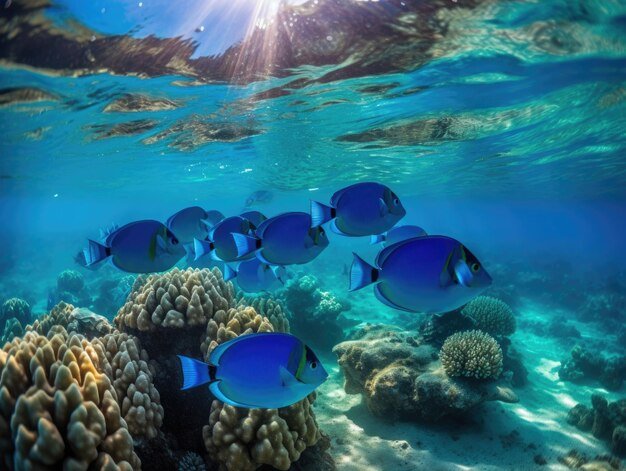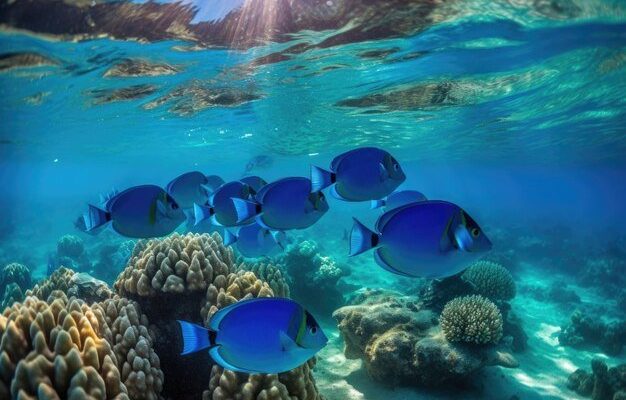
Picture this: you’re setting up your stunning reef aquarium, full of colorful corals and intriguing marine life. You want it to be a thriving ecosystem where every inhabitant coexists peacefully. The blue tang, with its playful nature and vibrant coloring, seems like a perfect addition. However, understanding how it interacts with corals and other fish is essential for maintaining a harmonious underwater environment.
So, let’s explore the compatibility of the blue tang reef and how you can ensure a happy home for your aquatic friends!
Understanding the Blue Tang’s Nature
The blue tang, also known as the palette surgeonfish, comes from the warm waters of the Pacific Ocean. This fish is not just a pretty face; it has a fascinating personality, often darting around the tank and interacting with its surroundings. When thinking about adding a blue tang to your reef tank, it’s crucial to understand its behavior. These fish can be quite territorial, especially as they mature.
In a home aquarium, blue tangs need space to swim and explore. If they feel cramped, they might become aggressive toward other fish, leading to squabbles that affect the entire ecosystem. Therefore, keeping the tank size in mind is essential. A tank of at least 75 gallons can provide the room they need to thrive.
Another important aspect of their nature is their feeding habits. Blue tangs are herbivores, meaning they primarily eat algae and plant matter. Providing a diet rich in greens is crucial for their health and happiness. You should offer them a mix of seaweed, spirulina, and high-quality pellets to keep them healthy and vibrant.
Compatibility with Coral
You might be wondering, “How does the blue tang interact with coral?” The good news is that blue tangs usually have a friendly relationship with most coral species. They don’t eat or harm corals like some other fish do, which is a significant plus if you’re trying to maintain a thriving reef system.
However, coral placement is essential. If you have aggressive corals in your tank, there might be a risk of them stinging your blue tang. For example, some species of *SPS (small polyp stony)* corals can be quite aggressive. Keeping a balance between fish and coral types is vital to avoid conflict.
Additionally, maintaining water quality is crucial for both the blue tang and corals. Stable water parameters, including pH, salinity, and temperature, ensure that all tank inhabitants thrive together. Regular monitoring can help you spot any potential issues before they escalate.
Choosing Tank Mates for Blue Tang
When it comes to tank mates, the blue tang can be quite social but also picky. You’ll want to choose fish that are peaceful and not overly aggressive. Good tank mates include:
- Clownfish
- Cardinalfish
- Yellow tangs (though be cautious with more than one tang)
- Wrasses
Each of these fish typically gets along well with blue tangs and won’t challenge them for territory. However, it’s essential to introduce new fish carefully to avoid stress and aggression.
Avoid housing blue tangs with highly territorial species like triggerfish or damselfish. These fish can bully the blue tang, leading to stress and health issues. If you’re unsure about compatibility, researching each species before introducing them is always a smart move.
Water Quality and Environment
The health of your blue tang—and your entire reef tank—relies heavily on water quality. Blue tangs are sensitive to changes, so keeping a stable environment is key. Here are some essential parameters to monitor:
- pH: Ideally between 8.1 and 8.4
- Salinity: A range of 1.020–1.025 specific gravity
- Temperature: Approximately 75°F to 80°F
- Nitrite and Ammonia: Should be at 0 ppm
Maintaining these levels can help prevent stress and disease, contributing to a healthier tank. Regular water changes (about 10% weekly) can significantly improve water quality and provide a stable environment for all tank inhabitants.
Investing in a good quality filter and possibly a protein skimmer will also help keep your water crystal clear. Remember, a happy blue tang equals a healthier reef system!
Potential Problems and Solutions
Even with all the planning, things can sometimes go awry in a reef tank. Blue tangs are susceptible to certain issues, like ich, a common parasitic infection. Stress from overcrowding or poor water quality can increase the likelihood of such diseases.
If you notice your blue tang scratching against objects or developing white spots, it’s time to act quickly. You can treat ich with medication, but also consider improving environmental conditions. Here are some steps you can take:
- Isolate affected fish in a quarantine tank.
- Increase the temperature slightly (but carefully) to speed up the parasite life cycle.
- Use copper-based treatments or Hyposalinity to help eliminate the parasite.
- Ensure your tank isn’t overcrowded and that your water quality is excellent.
Regular observation can help you spot these issues early. Keeping a close eye on your blue tang will allow you to act quickly if any problems arise.
The Benefits of a Blue Tang in Your Reef Tank
So, why should you consider adding a blue tang to your reef tank? Apart from their stunning appearance, blue tangs play a vital role in maintaining tank balance. Their grazing helps control algae growth, preventing it from taking over your corals.
Additionally, they bring a lively personality to your aquarium. Their playful nature and curious behavior can create an entertaining and dynamic environment. If you’ve ever watched a blue tang zigzag through the water, you know how captivating they can be!
Another bonus is their compatibility with a wide range of tank mates and corals. With careful planning and attention to their needs, you can create a thriving reef ecosystem that showcases the beauty of both coral and fish.
Final Thoughts on Blue Tang Compatibility
In conclusion, the blue tang can be a safe and exciting addition to your reef aquarium if you plan carefully. By understanding their needs and behavior, choosing suitable tank mates, and maintaining excellent water quality, you can create a peaceful environment for all inhabitants.
Remember, the goal is to foster a healthy ecosystem where the blue tang can flourish alongside corals and other fish. With a little care and attention, your blue tang will become a vibrant centerpiece in your underwater world! So, are you ready to take the plunge and welcome this beautiful fish into your tank?

